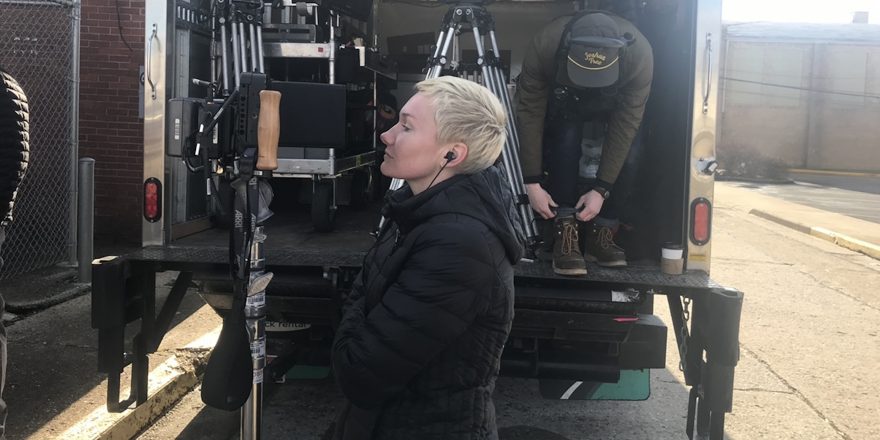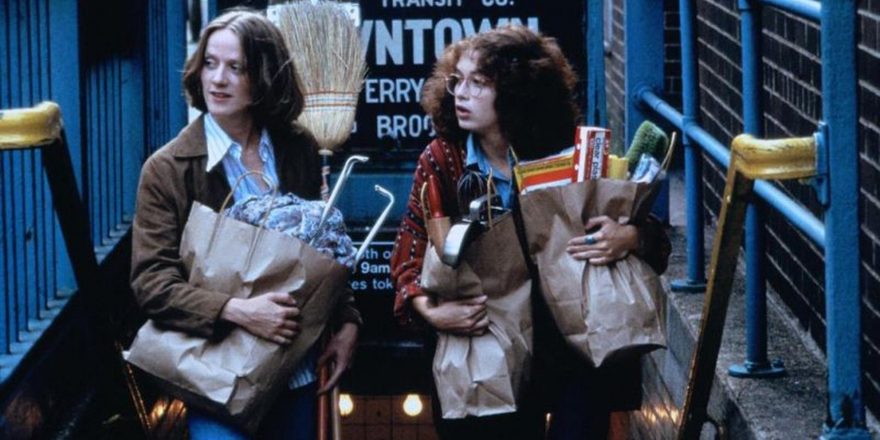My debut feature, Holler, is about a young Appalachian woman who joins a scrap-metal crew in order to fund her education. There is a scene about a third of the way through the film in which the protagonist, Ruth, tries to turn in her final high-school paper, but her teacher refuses it for being late. He looks her in the eyes and levels with her: student loan debt is a terrible burden for girls like her that come from poor families, persuading her to give up her dreams and find a more sensible job in town, instead. Rather than being discouraged, Ruth pushes her paper back across the desk. She decides to give herself the permission that no one else would give her.
This is the scene most people want to talk with me about after watching my film. It’s crushing to watch, but it was also crushing to live. Even though I left high school many years ago, I continue to live through moments like that, even as a filmmaker. I’ve learned that no one else is going to ever give me permission – I have to keep pushing the paper back across the desk.
Holler was made on location in my hometown of Jackson, Ohio, with few luxuries, in the middle of a polar vortex, and yes, it was a difficult shoot. But the most challenging period in the Holler saga wasn’t production, it was the four years I spent searching for financing between when I finished the script and cameras started rolling. It is a chunk of time that I have trained my mind to forget, a never-ending stream of no’s. At the heart of my film lies the economic reality for an Appalachian girl’s fight to go to college, so it feels appropriate to unpack the economic realities of my fight to tell that story.
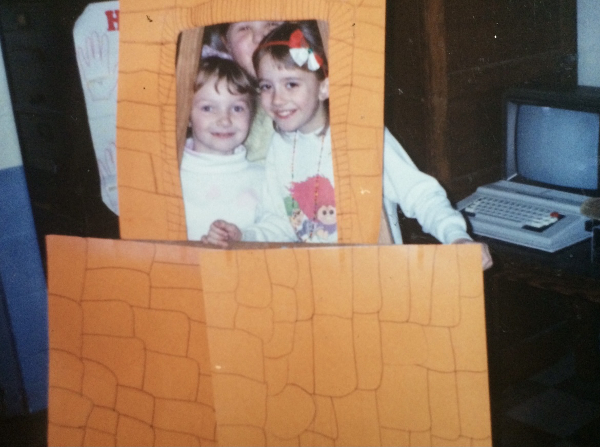
My public school, Jackson Elementary School, didn’t fund film and television experiences for students. Instead, we learned storytelling in other ways. In third grade, my class was split into groups and we had to perform five- to 10-minute scenes from plays we’d studied earlier in the week. I didn’t like any of the assigned plays, so I created a queen character named Isabella and we built a castle for her from construction paper. That was the first thing that I ever directed. I failed the assignment, but from that point on, I knew what I wanted to do with my life.
In my senior year of high school, I showed up to a meeting with my guidance counselor with packets I had ordered from different film schools across the country. I was going to be a first-generation college student and I needed help navigating the application process. After glancing at the names of the schools on the packets, she pushed them aside and told me that there was no way I would get into any of them. Instead, there was a local IT program and she was willing to put in a phone call for me. I told her that I didn’t want to work in IT, that I wanted to make films. I didn’t have access to cameras, lighting equipment, or a school system that was well funded in the arts. I didn’t even have consistent access to the internet in my rural community. I needed to go to one of these schools. I slid the packets back across the desk and got a blank stare in response.
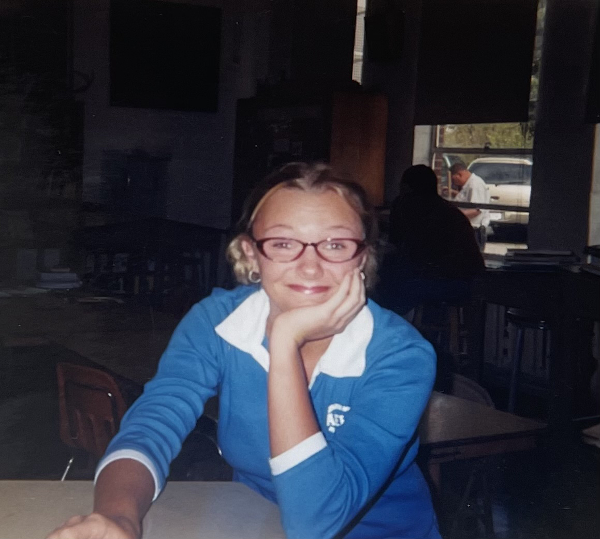
It would be a few years before I reopened the door to filmmaking. After joining the Army National Guard and completing basic training, I enrolled at Wright State University in Dayton, Ohio, not far from where I grew up. When I got there, I remember being in a hallway filled with white male students who had come from schools with robust media programs. I was already behind and failed to pass the exam needed to enter the school’s film production program because of it. Instead of waiting a whole year to reapply, I pivoted to studying cinema history. I played catch-up by studying every auteur film director I could and started learning photography by making my own black-and-white 35 mm prints that I developed in a dark room at the university. As I honed my eye, I started writing scripts as well. I wrote screenplay after screenplay, entering into every major writing competition that I could. Once I began placing in them, I knew I was getting better and applied to UCLA’s MFA screenwriting program. I gave myself permission to learn everything the film production program would not allow me to, and after I was accepted, I moved across the country to Los Angeles.
Within the elite circles of a top-tier film school, you have to pitch your ideas to instructors in order to get selected for a class. The first story I pitched centered on coal miners trapped after an explosion, but it didn’t focus on action or set pieces, rather I used the situation to force two characters to face the issues they were ignoring above ground. It was almost universally rejected and I found myself on the outside once again. While my peers had internships at fabulous companies and worked as assistants, gaining a strong grasp on the business side of filmmaking, I felt intimidated by the industry and their exposure to Hollywood. But none of that noise had anything to do with the craft and I still had to write something, so I wrote the coal-miner screenplay anyway.
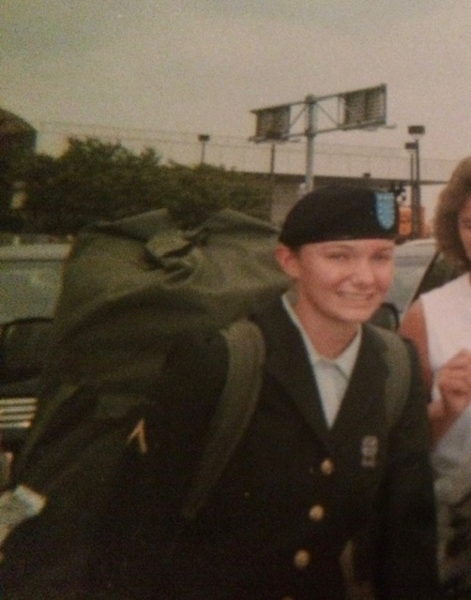
It won the dramatic writing award at UCLA’s annual film screenwriter’s showcase and I got a paid writing gig right out of school. That was the first time I learned to bet on myself. For me, writing is part of the directing process, because my mind is sorting through what will be told in visual language and what needs to be spoken. As time went on, I found support for the writing side of me and not the directing side. Some in the industry told me that women made better writers than directors, so I decided to specifically write something I could make on my own.
I remember sitting on a park bench with Adam Cobb, my filmmaking partner who I met in film school, trying to figure out a more manageable approach to getting a film off the ground. It needed to be one that took permission away from others, as much as possible. I needed to create something that no one would ask me to give away to someone else, something so personal that no one else could make it. And it needed to have a manageable budget – no big war scenes, no big stunts, movie stars or sound stages. It was there that the idea for Holler was born.
One person I did need permission from was a financier, as I couldn’t make the movie for free. In the early months of searching for money, it became clear that we needed to bring on another producer, one who had connections to money, more experience and would be a known quantity to financiers. As we pushed forward building up the film, I found that some of the things I had done to keep costs low on the production side actually made it more difficult to raise money. Since we would be filming in my hometown with many first-time actors, casting a big star would take away from the authentic feel of the film, even if it would help with money. I wanted the lead we cast as Ruth to be a discovery, and Jessica Barden nailed her audition and decided to take a chance on me. As we approached financier after financier, the film was either too small, I was too unproven, or they still asked if I would be interested in a more established director making it.
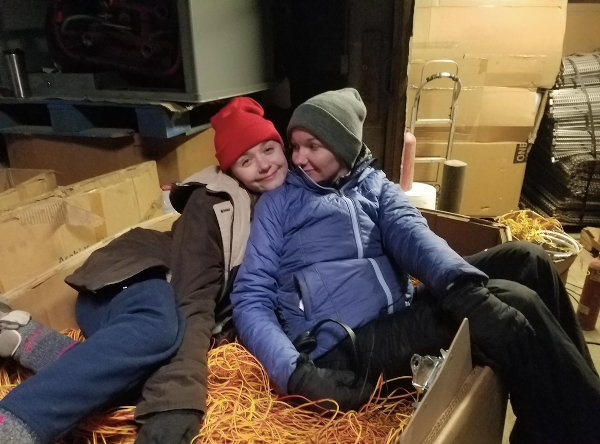
Time passed and it felt like I would never find anyone who would trust in my vision for the film – and so producers and start dates came and went too. It wasn’t until the year before filming that I was introduced to Paul Feig, who by some miracle decided to come on board as an executive producer. Though his involvement opened some doors, Paul still struggled to convince anyone to trust me with a film. The clock was running out on Jessica because she was missing out on other opportunities because of Holler, and it didn’t feel fair to keep her from work after she had been so loyal.
Meanwhile, I was working less and less as a screenwriter, because my days were devoted to researching potential financing partners, flying back and forth between Los Angeles and New York to meet with them, laying the foundation for a production in a remote part of Ohio, and going broke in the process. I wasn’t sleeping and was deeply anxious and depressed. We had taken the budget as low as it could go, and we had knocked on every door we could. I remember a call from the sales agent numbering the 70 rejections we had received and telling me that there was no one left to go to for financing. I couldn’t call family for feature-film money (they didn’t have it), max out credit credits (my credit line wasn’t big enough) or raise what I needed on Kickstarter. I had sacrificed my finances and my personal life in order to try to make my film, and had nothing to show for it.
The next day, Jessica gave me the uncomfortable news that she couldn’t continue passing on other opportunities. I gave her my blessing to move on and neither of us was happy about it, because we both cared deeply about Holler. Thing is, there was financing out there, but it seemed nobody was going to trust me with their money.
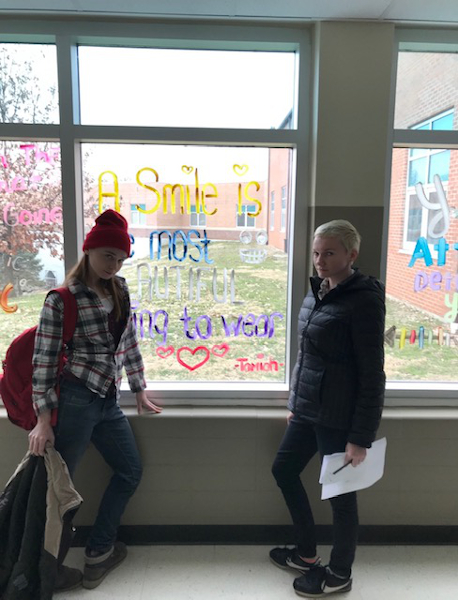
In the summer of 2018, I made a promise to myself that if nobody was willing to make an investment in me by end of the year, I would quit filmmaking and figure out a different life. I had a peek behind the curtain of the craft I loved and I realized that I just wasn’t the type of person who was able to get the money to tell their story. Maybe an art form that required less people and permission would be a better fit. I even briefly stopped loving movies, because watching them was a reminder of what I couldn’t do.
I took a few weeks to get my bearings and late one night I Googled, half-jokingly, “Does anyone in the world give money to female directors?” I stumbled upon a news article on a new company actually looking to do just that. I recognized one of the names and I called a mutual contact and he set up a meeting. Paul, Adam, and I walked into a meeting for the first time filled with all women, top to bottom, with economic power. A week later, they agreed to fully finance Holler and I danced in my kitchen.
Many pieces fell into place after that. Though we endured more hardship in the process, it was nothing compared to the years of struggling to get someone to take a financial leap of faith with me. There is no doubt that the movie industry is big and powerful and full of amazing opportunities, but there was no seat for me at that table. After all, a company outside the system had to be formed to specifically create opportunities for directors like me.
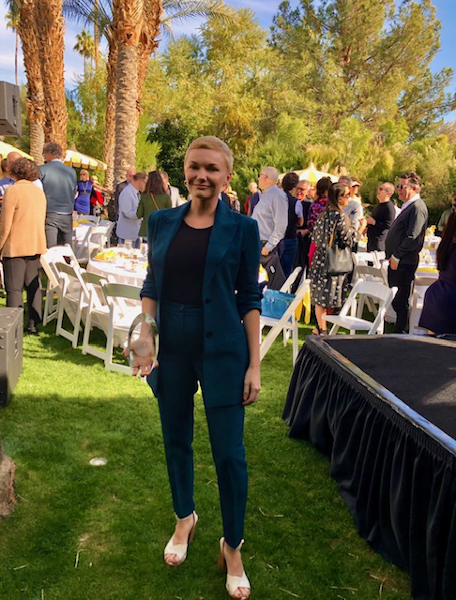
Holler taught me how to take ownership of my fate and forge my own path. It requires outside-the-box thinking, being solution-oriented, commitment, and a fucking insane amount of resilience. Filmmakers like me can’t rely on the way things have always been done and the way films have always been made, because those methods don’t favor us. We have to give ourselves permission and create our own table and be willing to pull up a chair for others like us.
As Jessica and I filmed the classroom scene in Holler, it occurred to me that my 33-year-old self was still that girl sliding her paper across a desk to a person who didn’t want it.
Featured image shows Nicole Riegel during her time at UCLA film school. All images courtesy Nicole Riegel.



